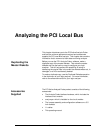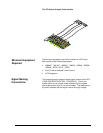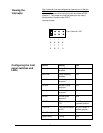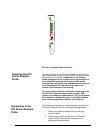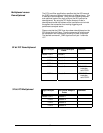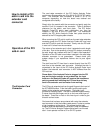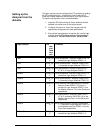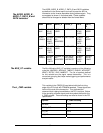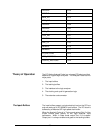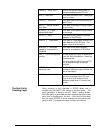
The card edge connector of the PCI Active Analysis Probe
module can accommodate one 32 or 64 bit 5V OR 3V PCI add in
card. The extender card connector is either a 3V or 5V
connector depending on how the board was ordered and
configured at the factory.
How to install a PCI
add-in card into the
extender card
connector
Simply align the module with the connector and gently push the
module in until it is seated in the connector. There is sufficient
clearance for the add-in card front plate. The PCI Active
Analysis Probe/PCI add-in card combination can then be
installed in any slot of the PCI Local bus. For mechanical
stability the PCI Active Analysis Probe front plate should be
secured to the PCI target system chassis.
When removing the PCI add-in card from the card edge extender
connector grasp the PCI Active Analysis Probe with one hand
and the PCI add-in card with the other. Gently rock the PCI add-
in card until it is free from the connector.
Operation of the PCI
add-in card
The nature of an extender card is that it extends the etch length
of the bus. Due to the sensitivity of most PCI designs, extending
the etch length can interfere with the PCI add-in card operation.
Operation of the PCI add-in card when installed in the card edge
extender connector is not guaranteed. Please check your
system design if you experience failures due to poor signal
fidelity.
The etch from the PCI local bus is routed directly from the PCI
local bus to the extender card connector. Although the etch is
connected to the input of the PCI Active Analysis Probe input
buffers, the extender card connector is NOT buffered from the
PCI local bus.
Please Note: If the Analysis Probe is plugged into the PCI
bus and the logic analyzer is not powered up, the input
buffers on the Analysis Probe will create a low impedance
path to ground thus inhibiting the PCI local bus and any
card in the extender card connector from working.
The Extender Card
Connector
The PCI bus is extended up from the gold fingers to the input of
the IDT162260 buffers. From the buffer input the etch goes
directly to the extender card connector. The buffer input
provides a clamping diode. The etch is extended approximately
5 inches from the gold fingers and is on the inner most layer of
the board. There are no via’s on this inner layer in order to give
this etch a direct route.
One issue that has been encountered with using the extender
card connector is that the buffers need power in order to provide
a high impedance to the signal. This means that the logic
analyzer must be attached to the Analysis Probe and powered
up. The PCI Active Analysis Probe module itself is a universal
card. It can operate in either a 5V or 3V PCI system.
15




